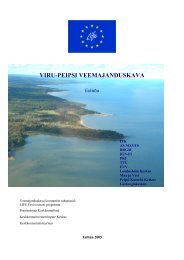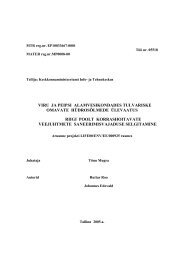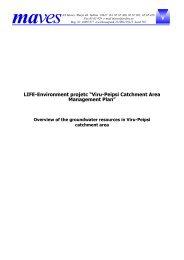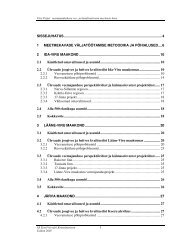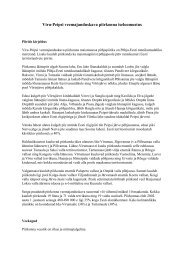Viru-Peipsi veemajanduskava - Keskkonnaministeerium
Viru-Peipsi veemajanduskava - Keskkonnaministeerium
Viru-Peipsi veemajanduskava - Keskkonnaministeerium
You also want an ePaper? Increase the reach of your titles
YUMPU automatically turns print PDFs into web optimized ePapers that Google loves.
3.2.4 Jõgede ökoloogiline seisund<br />
54<br />
3.2.4 The Ecological Status of Rivers<br />
VRDs on veekogudele avaldatava inimtegevuse<br />
morfoloogilise ja hüdroloogilise mõju iseloomustamiseks<br />
toodud sisse spetsiaalne mõiste – „oluliselt<br />
muudetud veekogu“ ehk pinnaveekogu, mis<br />
on inimtegevusest põhjustatud füüsiliste muudatuste<br />
tõttu oluliselt muutunud ning ei saa oma<br />
olemuse tõttu saavutada head ökoloogilist seisundit.<br />
Selliste veekogude jaoks tuleb „hea ökoloogilise<br />
seisundi“ asemel määratleda „hea ökoloogiline<br />
potentsiaal“. Siinjuures tuleb rõhutada,<br />
et veekogu võib määrata oluliselt muudetuks<br />
ainult füüsiliste muutuste tõttu, mitte halva veekvaliteedi<br />
ehk keemiliste muutuste põhjal. Samal<br />
ajal ei ole mõtet määrata veekogu „oluliselt<br />
muudetuks“ juhul, kui vaatamata füüsilistele<br />
muutustele on veekogu ikkagi heas ökoloogilises<br />
seisundis. Näiteks jõgi, mis 40 aastat tagasi sirgeks<br />
kaevati, võib olla tänapäevaks oma hea ökolooglise<br />
seisundi taastanud. <strong>Viru</strong>-<strong>Peipsi</strong> jõgedest<br />
on esialgu määratud „oluliselt muudetuks“ Võhandu<br />
jõe lõik Ruusast Räpina paisuni ja Pedja<br />
jõgi Jõgevalt Härjanurme paisuni.<br />
Eesti Looduhoiukeskuse hinnangul on <strong>Viru</strong>-<strong>Peipsi</strong><br />
piirkonna 28 jõel paisude näol kaladele 83 ületamatut<br />
ja 12 raskesti ületatavat rändetõket. Jõgede<br />
ökoloogilise seisundi hindamisel ei lähtutud<br />
hea seisundi saavutamisel kaugeltki mitte kõikide<br />
paisude likvideerimise nõudest. Nendel juhtudel,<br />
kui paisul on oluline kultuurilooline, asulakujunduslik,<br />
hüdroenergeetiline või mõni muu ühiskonna<br />
seisukohast oluline funktsioon, nähti ette<br />
paisu säilimine. Näitena võib tuua Põltsamaa jõe,<br />
mille ökoloogiline hinnang on vaatamata heale<br />
veekvaliteedile rahuldav. Põltsamaa jõe kalastikule<br />
ja hüdromorfoloogilisele seisundile on äärmiselt<br />
halvasti mõjunud mitmed jõele rajatud paisud.<br />
Põltsamaa jõel on praegu 6 kaladele ületamatuks<br />
rändetõkkeks olevat paisu: Ao ülemine ja<br />
alumine pais (112 ja 113 km suudmest), Rutikvere<br />
(63 km), Põltsamaa (38 km), Kamari ülemine<br />
ja alumine pais (33 km). Paisud jagavad jõe<br />
seitsmeks üksteisest isoleeritud jõelõiguks. Kõige<br />
enam kahjustavad jõe kalavarusid Kamari paisud,<br />
lõigates ülesvoolu jäävad jõeosad ära nii Põltsamaa<br />
jõe alamjooksust kui ka tervest ulatuslikust<br />
Emajõe-<strong>Peipsi</strong>-Võrtsjärve veesüsteemist. Kuna<br />
Emajões ning enamikus selle suuremates lisajõge-<br />
WFD has introduced a special term to characterise<br />
the morphological and hydrological effect of human<br />
activity on water bodies – “heavily modified<br />
water body” or a surface water body significantly<br />
changed due to the physical changes caused by<br />
human activity and where “good ecological status”<br />
cannot be achieved. For such rivers instead of<br />
“good ecological status” the term “good ecological<br />
potential” shall apply. It should be stressed here<br />
that a water body can be classified heavily modified<br />
water body solely due to the physical<br />
changes. The low water quality or the chemical<br />
changes cannot be the basis for the classification<br />
“significantly modified”. At the same time there is<br />
no point in classifying a water body as “heavily<br />
modified” when despite the physical changes the<br />
water body still has good ecological status. For instance,<br />
a river that was straightened 40 years ago<br />
may have restored the good ecological status by<br />
now. The stretch in the Võhandu River from Ruusa<br />
to the Räpina dam and the section in the Pedja<br />
River from Jõgeva to the Härjanurme dam have<br />
had the preliminary classification “heavily modified”<br />
in <strong>Viru</strong>-<strong>Peipsi</strong> region.<br />
Wildlife Estonia has estimated that there are 83<br />
dams, definite obstacles to fishes and 12 dams<br />
hard to pass during their migration. When assessing<br />
the ecological status of the rivers, the dismantling<br />
of all dams was not required in order to<br />
achieve the good ecological status. In cases where<br />
the dams have significant historical, aesthetic, hydropower<br />
or any other function considered important<br />
to the society, the dams will be preserved.<br />
The Põltsamaa River serves as a good example.<br />
The ecological status of the river is moderate despite<br />
the good water quality. Several dams<br />
erected in the river have adversely affected the<br />
fish fauna and the hydromorphological status of<br />
the river. There are 6 dams in the river at present.<br />
They all block the movement of fish during the<br />
migration period: the upper and the lower Ao<br />
dams (112 and 113 km from the river mouth),<br />
Rutikvere (63 km), Põltsamaa (38 km) and the<br />
lower and the upper Kamari dams (33 km). The<br />
dams divide the river into seven isolated water<br />
bodies. The Kamari dams have the most harmful<br />
effect since they cut the upstream stretches of<br />
the river off from both, the lower course and the<br />
extensive Emajõgi-<strong>Peipsi</strong>-Võrtsjärv water system.



